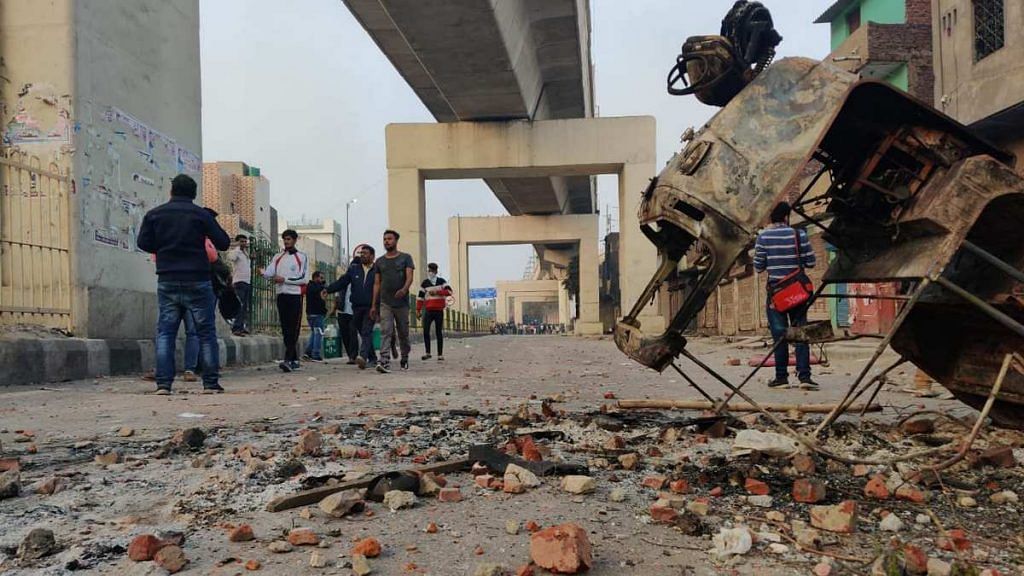New Delhi: During his press conference Tuesday, US President Donald Trump ducked questions regarding the communal riots that Delhi was witnessing during his visit, but the global media remained squarely focussed on the continuing violence in India’s capital city.
Almost every single report mentioned the words “just a few kilometers away” — making a stark juxtaposition about how Delhi’s northeast was burning just a little distance away from where Trump was.
Be it American media or Australian, all reports provided vivid descriptions of mob violence, the Muslim neighbourhoods and shops being targeted, and the lack of any effective police action to quell the riots. Some news publications also looked to provide a blow-by-blow perspective on how Modi’s “Hindu nationalist” agenda “intensified” following his May 2019 re-election and has eventually led to open “sectarian violence”.
Trump in town, violence in the next block
A range of publications such as the Washington Post, New York Times, CNN, Financial Times, BBC, Al Jazeera, and Strait Times, among others, provided comprehensive reports of what transpired in north-east Delhi on 25 February. And this reportage was often contrasted with Trump’s grand reception “just a few kilometers away”.
Foreign Policy Magazine’s newsletter ‘South Asia Briefing’ opened by stating, “It was the best of times, it was the worst of times.”
The report by Washington Post tried to capture the nature of violence in India’s capital in the very first line of its report as its headline read Wednesday: ‘Worst communal violence in Delhi in decades leaves 17 dead as Trump visits India’.
“Rioters roamed the streets with iron rods and wooden sticks, demanding to know whether people were Hindus or Muslims,” said the Post report. “Mosques were damaged and shops were set ablaze, sending smoke billowing high into the air. People with gunshot wounds and blunt trauma from hurled stones rushed into a nearby hospital,” it further added.
Financial Times and New York Times carried vivid reports filed by their local correspondents, detailing how mobs attacked Muslim neighbourhoods as Trump and Modi indulged in their bilateral dialogue.
The story by New York Times was headlined: “New Delhi streets turn into battleground for Hindus and Muslims.”
And it went on to note, “In other parts of New Delhi, Mr. Trump and Prime Minister Narendra Modi carried on with sightseeing and meetings, seemingly unaffected as the tension and protests that have roiled the capital over Mr. Modi’s Hindu-first policies exploded into rioting and gang fighting.”
Germany’s Der Spiegel had a report that was run with the headline, “Showing off outside, protest inside”.
Al Jazeera also featured a comprehensive coverage of the situation in Delhi. Its reports were curated using several Indian news and social media sources.
One of their reports highlighted inadequate police deployment and action. “On Monday, police used tear gas and smoke grenades but struggled to disperse the stone-throwing crowds,” it said.
Online reports by several publications showcased videos circulating on social media and showing the gruesome nature of violence at play in Delhi.
Also read: Who is Kapil Mishra? BJP leader being blamed for Delhi riots had once called Modi ISI agent
‘Hindu nationalist agenda hurting Brand India’
While some publications provided comprehensive ground reports, others ran perspective pieces, which aimed to trace how ‘Delhi got here’.
From CNN to BBC to MSNBC, they all looked at how since getting elected, Modi has notched up his “Hindu nationalist agenda”. They provide details of how the contentious citizenship amendment law led to nationwide protests, and eventually led to violence.
“Modi has been accused of taking steps to move India away from secularism and toward a Hindu state, including the citizenship bill,” noted the report by the CNN.
“The law has been criticised for introducing religion as a factor to determine citizenship, and has prompted concerns that Muslims declared as aliens under a proposed National Register of Citizens will not receive amnesty offered to other groups under the CAA,” said a report by Singapore’s Strait Times.
Meanwhile, MSNBC’s Chris Hayes remarked in his prime time show, “And now, as Prime Minister, Narendra Modi has launched a full-scale assault on the multi-religious principles India was founded on”, as pictures of mob clashes flashed on the screens.
The report by Financial Times ended with a quote from American scholar Ashley Tellis.
“Constituencies in the US are starting to look at India in different ways than they have looked at India in the past,” said Tellis. “There was a conviction in Washington that a good relationship with India was absolutely essential to our future. That conviction is beginning to break down.”
Also read: Trump is perfect to mediate on Kashmir. But India doesn’t have chutzpah to pull it off
